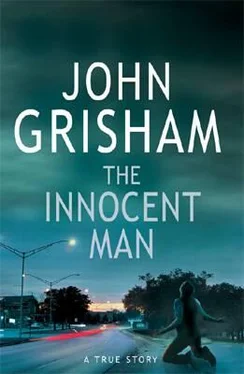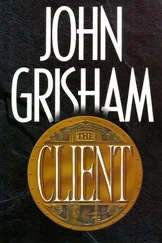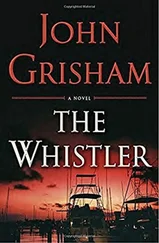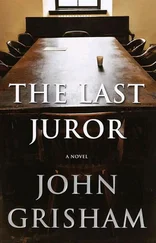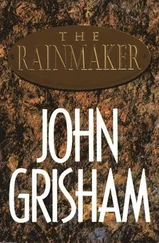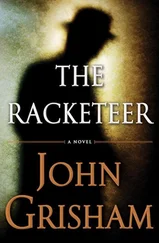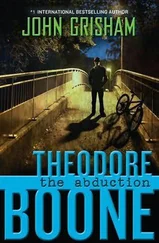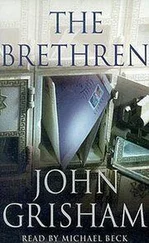Behind this room, and behind panels of one-way glass, is the witness room for the family of the killer. It has twelve folding chairs, but often a few are empty. Some inmates do not want their families to watch. Some inmates have no families.
And some victims have no families. Occasionally, their witness room is half-empty, too.
The two rooms are separated, and the two groups are carefully kept away from each other. As the witnesses take their places, they stare at nothing-mini-blinds block out the view of the death chamber.
The gurney enters and is wheeled into place. Technicians are waiting with intravenous tubes, one for each arm. When everything is properly inserted and adjusted, the miniblinds are raised and the witnesses can see the inmate. One-way glass prevents him from seeing the victim's family, but he can certainly see his own and often acknowledges them. A microphone protrudes from the wall two feet above his head.
A doctor attaches a heart-monitoring device. A deputy warden stands at a small white podium in a corner and records everything in a notebook. Next to him on the wall is a phone, just in case there is late-breaking news on the legal front or a change of heart in the governor's office. In years past a chaplain stood in another corner and read Scripture throughout the execution, but he retired.
The warden steps forward and asks the condemned if he or she has any last words. They often do not, but occasionally one will ask for forgiveness, or proclaim his innocence, or pray, or launch into some bitter denunciation. One sang a hymn. One shook hands with the warden and thanked him and his staff and the entire prison for taking such good care of him during his prolonged visit.
There is a two-minute time limit on the final words, but it is never invoked.
The condemned are always relaxed and low-key. They have accepted their fate and had many years to prepare for this moment. Many welcome it. They prefer death to the horror of living another twenty or thirty years on H Unit.
In a small room behind the gurney, three executioners are hiding. They are not to be seen. Their identities are unknown around the prison. They are not state employees, but freelancers of some variety who were secretly hired by an old warden many years ago.
Their arrivals and departures to and from McAlester are mysterious. Only the warden knows who they are, where they come from, and where they get their chemicals. He pays each of them $300 in cash for an execution.
The tubes from the inmate's arms run up and through two two-inch holes in the wall and into the small room where the executioners do their work. When the formalities are tidied up, and the warden is certain there will be no last-minute phone calls, he nods and the injections start.
First a saline solution is pumped in to open the veins. The first drug is sodium thiopental, and it quickly knocks out the inmate. Another flushing of saline solution, then the second drug, vecuronium bromide, stops the breathing. Another quick flush and the third drug, potassium chloride, stops the heart.
The doctor appears, does a quick check, pronounces death. The mini-blinds close fast, and the witnesses, many of them quite emotional, leave quickly and quietly. The gurney is rolled out. The body is taken to an ambulance. The family must make arrangements to retrieve it, or it goes to a prison cemetery.
Outside the prison gates, two groups hold two very different vigils. The Homicide Survivors sit in front of their RVs and wait for the welcome news that the execution is complete. Nearby is their display, a large three-panel memorial to the victims of the killers. Color photos of children and smiling students; poems to the dead; enlarged headlines announcing some horrific double murder; lots and lots of photos of those butchered by the inhabitants of death row. The memorial is called "Remember the Victims."
Not far away, a Catholic priest leads the other group in a circle of prayer and hymn singing. Some opponents of the death penalty attend every execution, praying not only for those condemned but also for their victims.
The two groups know and respect each other, but they strongly disagree.
When word comes from inside that the execution is over, more prayers are offered. Then the candles are extinguished, and the hymn-books are put away. Hugs are exchanged, farewells given. See you at the next execution.
When Ron Williamson arrived at McAlester on April 29, 1988, the H Unit was being discussed but not yet being built. Prison officials wanted a brand-new death row to house their growing inventory of capital inmates, but the legislature wouldn't spend the money. Ron was taken instead to F Cellhouse, home to eighty-one other condemned men. F Cellhouse, or The Row, as it was commonly called, comprised the bottom two floors of a wing of the old prison house, or Big House, a mammoth four-story building constructed in 1935 and finally abandoned fifty years later. Decades of overcrowding, violence, lawsuits, and riots led to its inevitable closing.
In the vast, empty, and decaying Big House, only F Cellhouse was used, and its sole purpose was to house condemned men in a lockdown environment.
Ron was processed at F Cellhouse. He was given two pairs of khakis, two blue shortsleeve shirts, two white T-shirts, two pairs of white socks, and two pairs of white boxer shorts. All the clothing had been well used. It was clean, but with permanent stains, especially the boxers. The shoes were black leather work shoes, also used. He was also given a pillow, blanket, toilet paper, toothbrush, and toothpaste. During his very brief orientation it was explained that he could purchase other toiletries, along with food and soft drinks and a few other items, at the prison commissary, better known as the canteen, a place he was not allowed to visit. Any money he received from the outside world would go into his account, from which he could purchase his "canteen." A man's canteen was his private little stockpile of goodies, something he protected fiercely in his cell.
When he had changed into his prison clothes and completed the processing, he was led to the wing, or run, where he would spend the next several years waiting for the state to execute him. His hands and ankles were cuffed. As he clutched his pillow, blanket, extra clothes, and other items, the guards opened the huge barred door and the parade began. Above his head, painted in large black letters, was his address: DEATH ROW.
The run was a hundred feet long and only twelve feet wide, with cells packed together on both sides. The ceiling was eight feet high.
Walking very slowly, Ron and his two guards proceeded down the run. It was a ritual, a brief welcoming ceremony. His neighbors knew he was coming and the catcalling began:
"New man on the run!"
"New meat!" "Hey, baby!"
Arms hung through the bars of the cell doors, almost within reaching distance. White arms, black arms, brown ones. Lots of tattoos on the arms. Act tough, Ron told himself. Don't show fear. They kicked the doors, yelled, called him names, threw out sexual threats. Always act tough.
He'd seen prisons before, and he'd just survived eleven months in the Pontotoc County jail. Nothing could be worse, he thought. They stopped at cell 16, and the noise went away. Welcome to The Row. A guard unlocked the door, and Ron entered his new home.
There's an old saying in Oklahoma that refers to someone incarcerated at McAlester -
"He's doing time at Big Mac." Ron stretched out on his narrow bunk, closed his eyes, and couldn't believe that he was locked away at Big Mac.
The cell was furnished with a set of metal-framed bunk beds, a metal desk with a metal stool that was mounted into the concrete, a stainless-steel toilet/sink combo, a mirror, a set of metal bookcases, and one light-bulb. It was sixteen feet long, seven feet wide, eight feet high. The floor was covered with black and white linoleum tiles. The brick walls were white and had been painted so many times they were smooth.
Читать дальше
